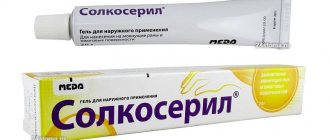Pharmacological properties
Pharmacodynamics.
Metronidazole is a derivative of 5-nitroimidazole, active against anaerobic protozoa and anaerobic bacteria. Metronidazole is effective against trichomonas vaginalis, giardia intestinalis, gardnerella vaginalis, entamoeba histolytica, lamblia spp., as well as obligate anaerobes: bacteroides spp. (b. fragilis, b. distasonis, b. thetaiotaomicron, b. vulgatus, b. ovatus), fusobacterium spp. and some gram-positive microorganisms: eubacterium spp., clostridium spp., peptostreptococcus spp., peptococcus spp. Metronidazole for external use has little antioxidant activity.
It has been established that metronidazole significantly reduces the production of active oxygen, hydroxyl radicals and hydrogen peroxide by neutrophils, which are potential oxidants and can harm tissues at the site of inflammation.
The mechanism of action of metronidazole is the biochemical reduction of the 5-nitro group of metronidazole by intracellular transport proteins of anaerobic microorganisms and protozoa. The reduced 5-nitro group of metronidazole interacts with the DNA of microorganisms, inhibiting its synthesis, which leads to the death of microorganisms.
When applied topically, the drug is effective against acne, but the mechanism of this action has not been fully studied.
Pharmacokinetics. When used externally, absorption of the drug is minimal and only a small amount of the drug is determined in the blood plasma. Absorbed metronidazole penetrates the placental barrier and the BBB. Cmax in the blood reaches 66 mg/ml (if 1 g of gel is applied, which is equivalent to 7.5 mg of metronidazole).
Metrogil
Metrogyl (INN metronidazole) is an antibacterial and protoprotozoal (used for infections caused by protozoa) drug from UNIQUE PHARMACEUTICAL Laboratories (India). Available in the form of tablets, solutions for intravenous administration, gels for external and intravaginal use. According to its chemical structure, it is a derivative of 5-nitroimidazole. Activity against anaerobic bacteria and protozoa is due to the ability to restore its 5-nitro group (which is part of the structure of metronidazole) due to the intracellular transport proteins of the above pathogens. The 5-nitro group that has undergone these changes interacts with bacterial DNA, suppressing the formation of proteins in them, resulting in the bactericidal effect of the drug. The spectrum of therapeutic action of Metrogil extends to Bacteroides spp., Clostridium spp., Entamoeba histolytica, Eubacterium spp., Fusobacterium spp., Gardnerella vaginalis, Giardiai ntestinalis, Lamblia spp., Peptococcus spp., Prevolella spp., Peptostreptococcus spp., Trichomonas vaginalis, Veillonella spp. In combination with amoxicillin, Metrogyl will be effective in eradicating Helicobacter pylori (amoxicillin in this case prevents the development of resistance to metronidazole). Aerobic microorganisms and anaerobes that can exist with access to oxygen are insensitive to metronidazole. Nevertheless, in conditions of mixed microflora, Metrogyl exhibits synergism with antibacterial drugs active against “pure” aerobes.
The drug increases the reactivity of neoplasms to radiation therapy, causes disulfiram-like phenomena, and activates the course of recovery processes. When taken orally, Metrogyl is quickly and completely absorbed from the digestive tract into the systemic circulation, showing a maximum concentration in plasma 2 hours after administration. It binds weakly to blood proteins. Elimination from the body is carried out by the kidneys. A fifth of the drug is eliminated in its original form. The half-life is 8 hours. In patients suffering from renal dysfunction, after repeated administration of the drug, accumulation of the active substance in the blood may occur. In this regard, in such patients the daily dose should be reduced. Metrogyl is incompatible with alcohol due to the disulfiram-like reaction mentioned above, manifested by cramping abdominal pain, vomiting, headache, and hyperemia. The combination of the drug with amoxicillin is permissible only for persons over 18 years of age. Long-term use of Metrogyl should be accompanied by monitoring of peripheral blood parameters. Symptoms such as dizziness and ataxia are a signal to stop the medication course. When treating sexually transmitted diseases with Metrogyl, you should abstain from sexual activity.
special instructions
Avoid getting the drug into your eyes. If the gel gets into your eyes, you must immediately rinse them with plenty of water.
The gel should not be applied to areas close to the eyes. The affected area should be cleaned before applying Metrogyl gel. After applying the drug, you can use cosmetics.
For ordinary acne, the use of Metrogyl gel should be combined with oral antibiotics.
When applied to a large surface area of the skin or in case of prolonged use of Metrogyl gel, there is a possibility of developing systemic side effects.
The drug should be prescribed with caution to patients with impaired hematopoietic function.
Metronidazole for topical use is not effective for the treatment of telangiectasia, which occurs with erythematosus.
Propyl parahydroxybenzoate (E216) and methyl parahydroxybenzoate (E218), which are part of the drug, can cause an allergic reaction (possibly delayed).
Use during pregnancy and lactation.
When taken orally, metronidazole crosses the placental barrier into breast milk in very significant concentrations.
Despite the fact that when applied topically, the concentration of metronidazole in the blood is low, Metrogyl gel is contraindicated in the first trimester of pregnancy, and in the second and third trimester it can be used if absolutely necessary.
Breastfeeding should be stopped during treatment.
Children. Do not use in children.
The ability to influence reaction speed when driving vehicles or operating machinery. The use of the drug at the indicated dose does not affect driving or working with potentially dangerous mechanisms.
Features of using Metrogil for acne
Like any other product, the gel must be applied to skin that has been previously cleansed of cosmetics and oil. Wash your face with warm water, dry and apply Metrogyl to the affected area or the entire face, depending on the severity of the rash and its location.
The gel does not contain oils or fats, so it is easily absorbed and does not leave an oily sheen. At the same time, it does not dry out the skin, does not provoke peeling and does not cause a feeling of tightness.
The duration of use of the acne gel is no more than 3-9 months, depending on the severity of the lesion. During this period, complete tissue regeneration will occur and unfavorable microflora will be destroyed.
In case of treatment of demodicosis, the gel is applied to the lesions and a small area of skin around them. For greater therapeutic effect, it is recommended to combine the drug with other anti-inflammatory drugs.
Dermatologists advise combining Metrogyl with any “talkers”, skincare cosmetics that you use every day, as well as other medications that are not analogues of metronidazole.
Many patients misunderstand the term “combine”. Use several means at the same time, i.e. putting one on top of the other is completely wrong. Use Metrogyl in the morning, and in the evening any other product prescribed to you by a cosmetologist or dermatologist. This combination will be the most effective and will speed up the process of treating rashes.
Don't forget about the rules of personal hygiene. Keep linen, towels, makeup brushes and other items that come into contact with your facial skin clean, and do not touch your face with your hands.
Interactions
When applied topically in recommended doses, no systemic interaction of Metrogyl gel with other drugs was detected. however, caution should be exercised when prescribing Metrogyl gel with certain medications.
Warfarin and other coumarin anticoagulants. Metronidazole enhances the anticoagulant effect, which leads to an increase in the time of prothrombin formation.
Phenobarbital. When used simultaneously with metronidazole, the antimicrobial activity of the latter decreases. The reason is the accelerated metabolism of metronidazole.
Disulfiram. Concomitant use increases the toxicity of the drugs, which can lead to the development of neurological symptoms.
Cimetidine. Suppresses the metabolism of metronidazole, which may lead to increased concentrations of metronidazole in the blood serum.
During systemic therapy with metronidazole, it is necessary to refrain from drinking alcohol, since a disulfiram-like reaction is possible.
Metrogyl®
Gastrointestinal disorders: epigastric pain, nausea, vomiting, diarrhea, glossitis, stomatitis, metallic taste in the mouth, decreased appetite, anorexia, dry oral mucosa, constipation, pancreatitis (reversible cases), discoloration tongue / “coated tongue” (due to the growth of fungal microflora).
Immune system disorders: angioedema, anaphylactic shock.
Nervous system disorders: peripheral sensory neuropathy, headache, convulsions, dizziness, encephalopathy and subacute cerebellar syndrome (impaired coordination and synergism of movements, ataxia, dysarthria, gait disturbance, nystagmus, tremor) have been reported, which are reversible after discontinuation of metronidazole , aseptic meningitis.
Mental disorders: psychotic disorders, including confusion, hallucinations; depression, insomnia, irritability, increased excitability.
Visual disturbances: transient visual disturbances, such as diplopia, myopia, blurred contours of objects, decreased visual acuity, impaired color perception; neuropathy/optic neuritis.
Blood and lymphatic system disorders: agranulocytosis, leukopenia, neutropenia, thrombocytopenia.
Disorders of the liver and biliary tract: increased activity of liver enzymes (aspartate aminotransferase, alanine aminotransferase, alkaline phosphatase), development of cholestatic or mixed hepatitis and hepatocellular liver damage, sometimes accompanied by jaundice; In patients treated with metronidazole in combination with other antibacterial agents, cases of liver failure requiring liver transplantation have been observed.
Skin and subcutaneous tissue disorders: rash, itching, skin flushing, urticaria, pustular skin rash, Stevens-Johnson syndrome, toxic epidermal necrolysis.
Renal and urinary tract disorders: brownish-reddish coloration of urine due to the presence of a water-soluble metabolite of metronidazole in the urine, dysuria, polyuria, cystitis, urinary incontinence, candidiasis.
General disorders and disorders at the injection site: fever, nasal congestion, arthralgia, weakness, thrombophlebitis (pain, hyperemia or swelling at the injection site).
Laboratory and instrumental data: flattening of the T wave on the electrocardiogram.
Note!
The description of the drug Metrogyl gel tube 30g on this page is a simplified author’s version of the apteka911 website, created on the basis of the instructions for use.
Before purchasing or using the drug, you should consult your doctor and read the manufacturer's original instructions (attached to each package of the drug). Information about the drug is provided for informational purposes only and should not be used as a guide to self-medication. Only a doctor can decide to prescribe the drug, as well as determine the dose and methods of its use.
Metrogyl for acne: instructions
The list of symptoms for which the drug is indicated is quite extensive:
- rosacea (rosacea);
- chronic inflammatory diseases of the sebaceous glands;
- seborrheic lesions;
- ulcers of the lower extremities;
- long-term non-healing wounds;
- soft tissue necrosis;
- haemorrhoids.
Metrogyl is equally effective against acne and hormonal rashes. It can be used to prevent infection of open wounds, chapping of the face and other serious injuries.
You can only buy acne gel at the pharmacy. The product is available without a prescription, but it is recommended to consult a doctor before use.



